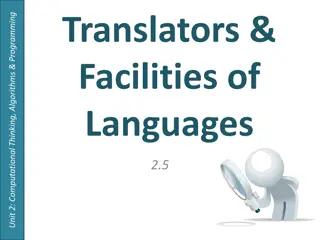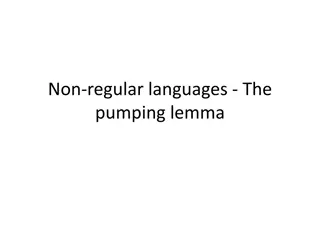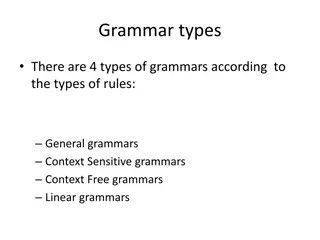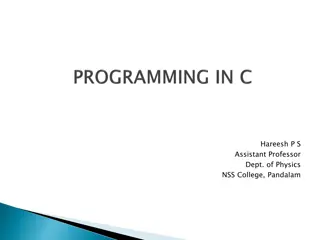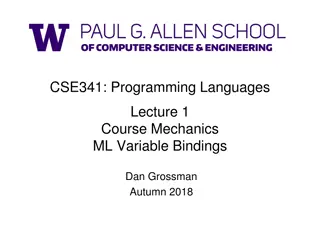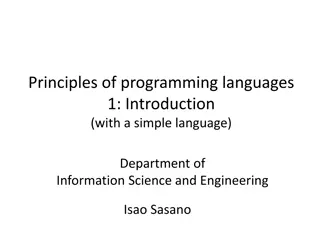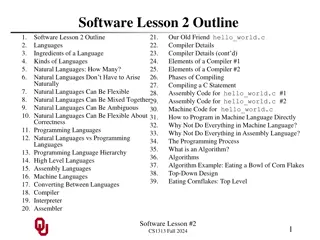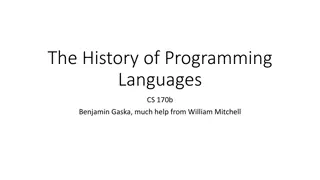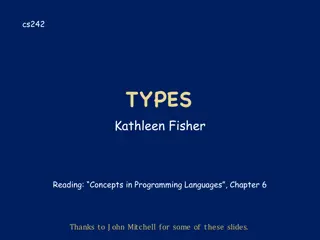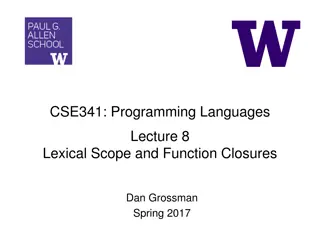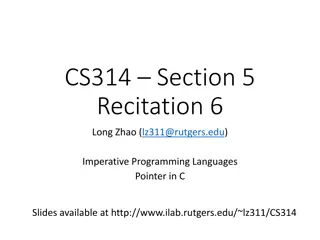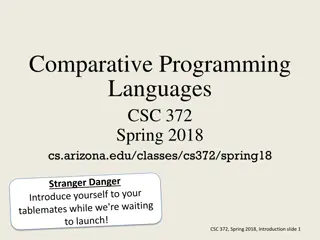General Discussion of Types in Programming Languages
This text delves into the fundamental concepts of types in programming languages, including compile-time vs. run-time checking, conservative program analysis, type inference, and polymorphism. It explores language goals, trade-offs, and the uses of types for program organization and error prevention. Additionally, it explains what type errors are and how they manifest in different programming languages.
Download Presentation

Please find below an Image/Link to download the presentation.
The content on the website is provided AS IS for your information and personal use only. It may not be sold, licensed, or shared on other websites without obtaining consent from the author.If you encounter any issues during the download, it is possible that the publisher has removed the file from their server.
You are allowed to download the files provided on this website for personal or commercial use, subject to the condition that they are used lawfully. All files are the property of their respective owners.
The content on the website is provided AS IS for your information and personal use only. It may not be sold, licensed, or shared on other websites without obtaining consent from the author.
E N D
Presentation Transcript
cs242 TYPES Kathleen Fisher Reading: Concepts in Programming Languages , Chapter 6
Outline General discussion of types What is a type? Compile-time vs run-time checking Conservative program analysis Type inference Will study algorithm and examples Good example of static analysis algorithm Polymorphism Uniform vs non-uniform impl of polymorphism Polymorphism vs overloading
Language Goals and Trade-offs Thoughts to keep in mind What features are convenient for programmer? What other features do they prevent? What are design tradeoffs? Easy to write but harder to read? Easy to write but poorer error messages? What are the implementation costs? Architect Programmer Programming Language Compiler, Runtime environ- ment Tester Diagnostic Tools
What is a type? A type is a collection of computable values that share some structural property. Examples Non-examples 3, True, \x->x Even integers f:Int Int | x>3 => f(x) > x *(x+1) Integer String Int (Int Bool Int) Bool Distinction between sets of values that are types and sets that are not types is language dependent.
Uses for Types Program organization and documentation Separate types for separate concepts Represent concepts from problem domain Indicate intended use of declared identifiers Types can be checked, unlike program comments Identify and prevent errors Compile-time or run-time checking can prevent meaningless computations such as 3 + true Bill Support optimization Example: short integers require fewer bits Access record component by known offset
What is a type error? A type error is something the compiler/interpreter reports when I make a mistake in my syntactically correct program? Languages represent values as sequences of bits. A type error occurs when a bit sequence written for one type is used as a bit sequence for another type? A type error occurs when a value is used in a way inconsistent with its definition.
Type errors are language dependent Array out of bounds access C/C++: runtime errors. Haskell/Java: dynamic type errors. Null pointer dereference C/C++: null pointer dereferences are run-time errors. In Haskell/ML, pointers are hidden inside datatypes. Null pointer dereferences correspond to incorrect use of these datatypes. Such errors are static type errors.
Compile-time vs Run-time Checking JavaScript and Lisp use run-time type checking f(x) Make sure f is a function before calling f. ML and Haskell use compile-time type checking f(x) Must have f :: A B and x :: A Basic tradeoff Both kinds of checking prevent type errors. Run-time checking slows down execution. Compile-time checking restricts program flexibility. JavaScript array: elements can have different types Haskell list: all elements must have same type Which gives better programmer diagnostics?
Expressiveness In JavaScript, we can write a function like function f(x) { return x < 10 ? x : x(); } Some uses will produce type error, some will not. Static typing always conservative if (big-hairy-boolean-expression) then f(5); else f(15); Cannot decide at compile time if run-time error will occur!
Relative Type-Safety of Languages Not safe: BCPL family, including C and C++ Casts, pointer arithmetic Almost safe: Algol family, Pascal, Ada. Dangling pointers. Allocate a pointer p to an integer, deallocate the memory referenced by p, then later use the value pointed to by p. No language with explicit deallocation of memory is fully type-safe. Safe: Lisp, Smalltalk, ML, Haskell, Java, JavaScript Dynamically typed: Lisp, Smalltalk, JavaScript Statically typed: ML, Haskell, Java
Type Checking vs.Type Inference Standard type checking: int f(int x) { return x+1; }; int g(int y) { return f(y+1)*2; }; Examine body of each function. Use declared types to check agreement. Type inference: int f(int x) { return x+1; }; int g(int y) { return f(y+1)*2; }; Examine code without type information. Infer the most general types that could have been declared. ML and Haskell are designed to make type inference feasible.
Why study type inference? Types and type checking Improved steadily since Algol 60 Eliminated sources of unsoundness. Become substantially more expressive. Important for modularity, reliability and compilation Type inference Reduces syntactic overhead of expressive types. Guaranteed to produce most general type. Widely regarded as important language innovation. Illustrative example of a flow-insensitive static analysis algorithm.
History Original type inference algorithm was invented by Haskell Curry and Robert Feys for the simply typed lambda calculus in 1958. In 1969, Hindley extended the algorithm to a richer language and proved it always produced the most general type. In 1978, Milner independently developed equivalent algorithm, called algorithm W, during his work designing ML. In 1982, Damas proved the algorithm was complete. Already used in many languages: ML, Ada, Haskell, C# 3.0, F#, Visual Basic .Net 9.0, and soon in: Fortress, Perl 6, C++0x
uHaskell Subset of Haskell to explain type inference. Haskell and ML both have overloading, which slightly complicates type inference. We won t worry about type inference with overloading. <decl> ::= [<name> <pat> = <exp>] <pat> ::=Id | (<pat>, <pat>) | <pat> : <pat> | [] <exp> ::= Int | Bool | [] | Id | (<exp>) | <exp> <op> <exp> | <exp> <exp> | (<exp>, <exp>) | if <exp> then <exp> else <exp>
Type Inference: Basic Idea Example f x = 2 + x > f :: Int -> Int What is the type of f? + has type: Int 2has type: Int Since we are applying + to x we need x :: Int Therefore f x = 2 + x has type Int Int Int Int Overloaded functions introduce more cases to consider.
Step 1: Parse Program Parse program text to construct parse tree. f x = 2 + x Infix operators are converted to normal function application during parsing: 2 + x --> (+) 2 x
Step 2: Assign type variables to nodes f x = 2 + x Variables are given same type as binding occurrence.
Step 3: Add Constraints f x = 2 + x t_0 = t_1 -> t_6 t_4 = t_1 -> t_6 t_2 = t_3 -> t_4 t_2 = Int -> Int -> Int t_3 = Int
Step 4: Solve Constraints t_0 = t_1 -> t_6 t_4 = t_1 -> t_6 t_2 = t_3 -> t_4 t_2 = Int -> Int -> Int t_3 = Int t_3 -> t_4 = Int -> (Int -> Int) t_3 = Int t_4 = Int -> Int t_0 = t_1 -> t_6 t_4 = t_1 -> t_6 t_4 = Int -> Int t_2 = Int -> Int -> Int t_3 = Int t_1 -> t_6 = Int -> Int t_1 = Int t_6 = Int t_0 = Int -> Int t_1 = Int t_6 = Int t_4 = Int -> Int t_2 = Int -> Int -> Int t_3 = Int
Step 5: Determine type of declaration t_0 = Int -> Int t_1 = Int t_6 = Int -> Int t_4 = Int -> Int t_2 = Int -> Int -> Int t_3 = Int f x = 2 + x > f :: Int -> Int
Type Inference Algorithm Parse program to build parse tree Assign type variables to nodes in tree Generate constraints: From environment: constants (2), built-in operators (+), known functions (tail). From form of parse tree: e.g., application and abstraction nodes. Solve constraints using unification. Determine types of top-level declarations.
Constraints from Application Nodes f x t_0 = t_1 -> t_2 Apply function f to argument x: Because f is being applied, its type (t_0 in figure) must be a function type: domain range. Domain of f must be type of argument x (t_1 in figure). Range of f must be result type of expression (t_2 in figure). Hence we get the constraint: t_0 = t_1 -> t_2
Constraints from Abstractions f x = e t_0 = t_1 -> t_2 Function declaration: Type of function f (t_0 in figure) must be a function type: domain range. Domain is type of abstracted variable x (t_1 in figure). Range is type of function body e (t_2 in figure). Hence we get the constraint: t_0 = t_1 -> t_2.
Inferring Polymorphic Types Example: Step 1: Build Parse Tree f g = g 2 > f :: (Int -> t_4) -> t_4
Inferring Polymorphic Types Example: Step 2: Assign type variables f g = g 2 > f :: (Int -> t_4) -> t_4
Inferring Polymorphic Types Example: Step 3: Generate constraints f g = g 2 > f :: (Int -> t_4) -> t_4 t_0 = t_1 -> t_4 t_1 = t_3 -> t_4 t_3 = Int
Inferring Polymorphic Types Example: Step 4: Solve constraints f g = g 2 > f :: (Int -> t_4) -> t_4 t_0 = t_1 -> t_4 t_1 = t_3 -> t_4 t_3 = Int t_0 = (Int -> t_4) -> t_4 t_1 = Int -> t_4 t_3 = Int
Inferring Polymorphic Types Example: Step 5: Determine type of top-level declaration f g = g 2 > f :: (Int -> t_4) -> t_4 Unconstrained type variables become polymorphic types. t_0 = (Int -> t_4) -> t_4 t_1 = Int -> t_4 t_3 = Int
Using Polymorphic Functions Function: f g = g 2 > f :: (Int -> t_4) -> t_4 Possible applications: add x = 2 + x > add :: Int -> Int isEven x = mod (x, 2) == 0 > isEven:: Int -> Bool f add > 4 :: Int f isEven > True :: Int
Recognizing Type Errors f g = g 2 > f :: (Int -> t) -> t Function Incorrect use not x = if x then True else False > not :: Bool -> Bool f not > Error: operator and operand don t agree operator domain: Int -> a operand: Bool -> Bool Type error: cannot unify Bool Bool and Int t
Another Example Example: Step 1: Build Parse Tree f (g,x) = g (g x) > f :: (t_8 -> t_8, t_8) -> t_8
Another Example Example: Step 2: Assign type variables f (g,x) = g (g x) > f :: (t_8 -> t_8, t_8) -> t_8
Another Example Example: Step 3: Generate constraints f (g,x) = g (g x) > f :: (t_8 -> t_8, t_8) -> t_8 t_0 = t_3 -> t_8 t_3 = (t_1, t_2) t_1 = t_7 -> t_8 t_1 = t_2 -> t_7
Another Example Example: Step 4: Solve constraints f (g,x) = g (g x) > f :: (t_8 -> t_8, t_8) -> t_8 t_0 = t_3 -> t_8 t_3 = (t_1, t_2) t_1 = t_7 -> t_8 t_1 = t_2 -> t_7 t_0 = (t_8 -> t_8, t_8) -> t_8
Another Example Example: Step 5: Determine type of f f (g,x) = g (g x) > f :: (t_8 -> t_8, t_8) -> t_8 t_0 = t_3 -> t_8 t_3 = (t_1, t_2) t_1 = t_7 -> t_8 t_1 = t_2 -> t_7 t_0 = (t_8 -> t_8, t_8) -> t_8
Polymorphic Datatypes Often, functions over datatypes are written with multiple clauses: length [] = 0 length (x:rest) = 1 + (length rest) Type inference Infer separate type for each clause Combine by adding constraint that the types of the branches must be equal.
Type Inference with Datatypes Example: Step 1: Build Parse Tree length (x:rest) = 1 + (length rest)
Type Inference with Datatypes Example: Step 2: Assign type variables length (x:rest) = 1 + (length rest)
Type Inference with Datatypes Example: Step 3: Gen. constraints length (x:rest) = 1 + (length rest) t_0 = t_3 -> t_10 t_3 = t_2 t_3 = [t_1] t_6 = t_9 -> t_10 t_4 = t_5 -> t_6 t_4 = Int -> Int -> Int t_5 = Int t_0 = t_2 -> t_9
Type Inference with Datatypes Example: Step 3: Solve Constraints length (x:rest) = 1 + (length rest) t_0 = t_3 -> t_10 t_3 = t_2 t_3 = [t_1] t_6 = t_9 -> t_10 t_4 = t_5 -> t_6 t_4 = Int -> Int -> Int t_5 = Int t_0 = t_2 -> t_9 t_0 = [t_1] -> Int
Multiple Clauses Function with multiple clauses append ([],r) = r append (x:xs, r) = x : append (xs, r) Infer type of each branch First branch: > append :: ([t_1], t_2) -> t_2 Second branch: > append :: ([t_3], t_4) -> [t_3] Combine by equating types of two branches: > append :: ([t_1], [t_1]) -> [t_1]
Most General Type Type inference is guaranteed to produce the most general type: map (f, [] ) = [] map (f, x:xs) = f x : map (f, xs) > map :: (t_1 -> t_2, [t_1]) -> [t_2] Function has many other, less general types: > map :: (t_1 -> Int, [t_1]) -> [Int] > map :: (Bool -> t_2, [Bool]) -> [t_2] > map :: (Char -> Int, [Char]) -> [Int] Less general types are all instances of most general type, also called the principal type.
Type Inference Algorithm When the Hindley/Milner type inference algorithm was developed, its complexity was unknown. In 1989, Mairson proved that the problem was exponential-time complete. Tractable in practice though
Information from Type Inference Consider this function reverse [] = [] reverse (x:xs) = reverse xs and its most general type: > reverse :: [t_1] -> [t_2] What does this type mean? Reversing a list does not change its type, so there must be an error in the definition of reverse! See Koenig paper on Reading page of CS242 site
Type Inference: Key Points Type inference computes the types of expressions Does not require type declarations for variables Finds the most general type by solving constraints Leads to polymorphism Sometimes better error detection than type checking Type may indicate a programming error even if no type error. Some costs More difficult to identify program line that causes error. Natural implementation requires uniform representation sizes. Complications regarding assignment took years to work out. Idea can be applied to other program properties Discover properties of program using same kind of analysis
Haskell Type Inference Haskell uses type classes to support user-defined overloading, so the inference algorithm is more complicated. ML restricts the language to ensure that no annotations are required, ever. Haskell provides various features like polymorphic recursion for which types cannot be inferred and so the user must provide annotations.
Parametric Polymorphism: Haskell vs C++ Haskell polymorphic function Declarations (generally) require no type information. Type inference uses type variables to type expressions. Type inference substitutes for variables as needed to instantiate polymorphic code. C++ function template Programmer must declare the argument and result types of functions. Programmers must use explicit type parameters to express polymorphism. Function application: type checker does instantiation.
Example: Swap Two Values Haskell swap :: (IORef a, IORef a) -> IO () swap (x,y) = do { val_x <- readIORef x; val_y <- readIORef y; writeIORef y val_x; writeIORef x val_y; return () } C++ template <typename T> void swap(T& x, T& y){ T tmp = x; x=y; y=tmp; } Declarations both swap two values polymorphically, but they are compiled very differently.
Implementation Haskell Swap is compiled into one function Typechecker determines how function can be used C++ Swap is compiled into linkable format Linker duplicates code for each type of use Why the difference? Haskell ref cell is passed by pointer. The local x is a pointer to value on heap, so its size is constant. C++ arguments passed by reference (pointer), but local x is on the stack, so its size depends on the type.
Polymorphism vs Overloading Parametric polymorphism Single algorithm may be given many types Type variable may be replaced by any type iff::t t then f::Int Overloading A single symbol may refer to more than one algorithm Each algorithm may have different type Choice of algorithm determined by type context Types of symbol may be arbitrarily different In ML, + has types int*int real*real real, no others Int,f::Bool Bool, ... int,



